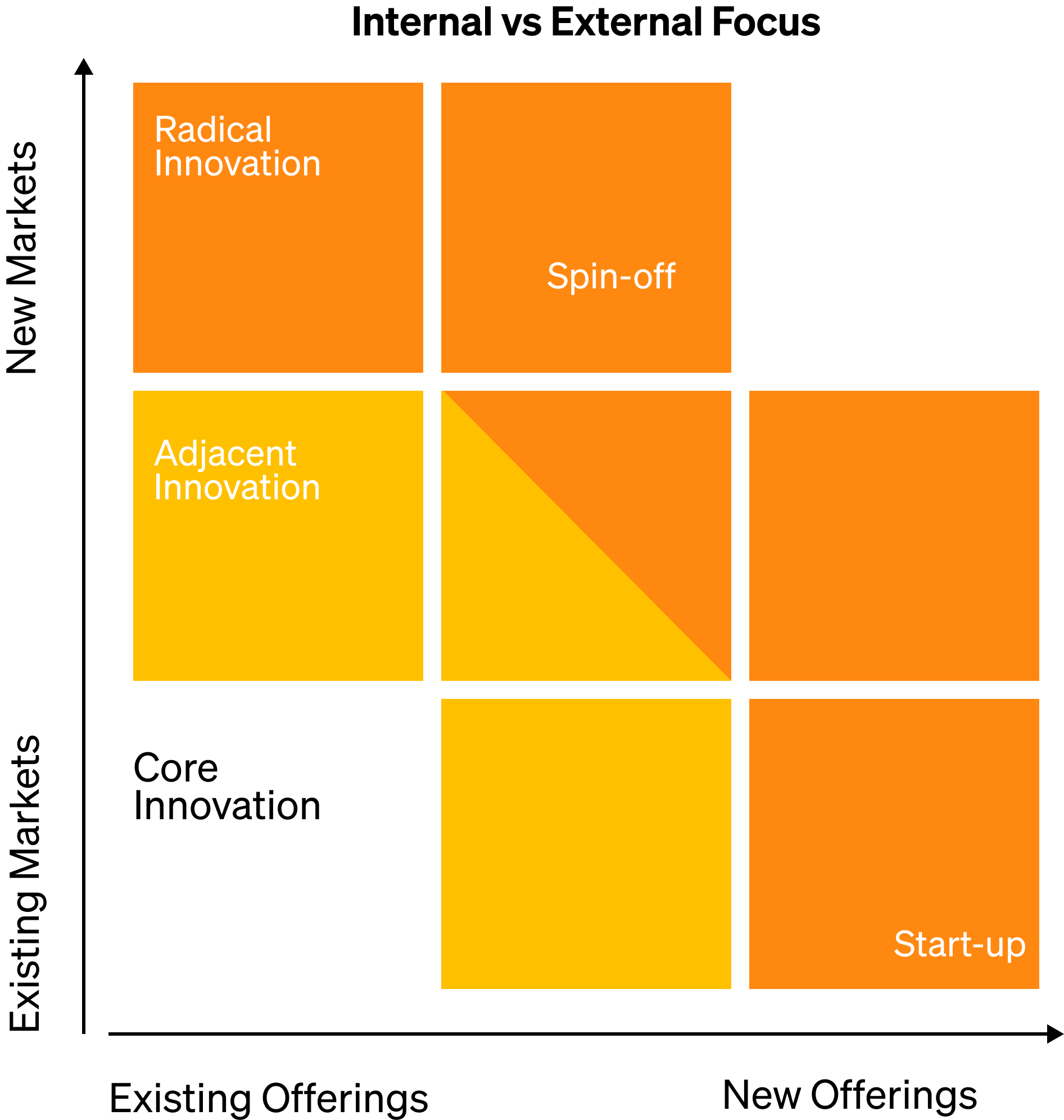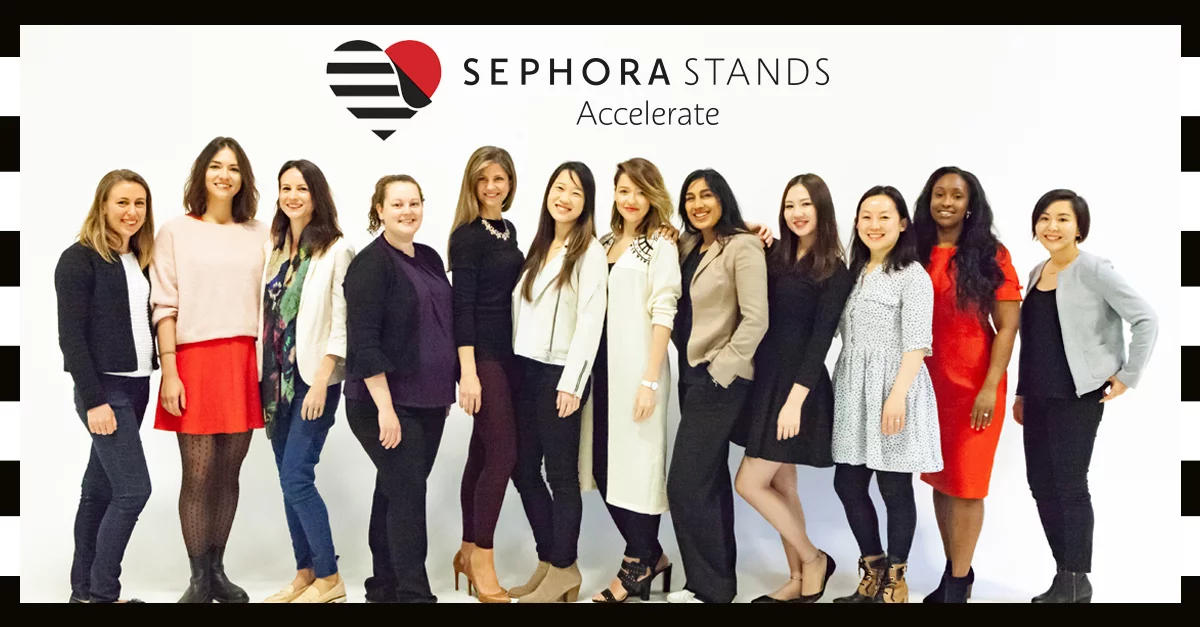Key takeaways
When it comes to innovation, evolution is the name of the game. So it’s not surprising that today’s landscape is beginning to look quite different than just a few years back. As technologies advance and customer demand changes, innovators and entrepreneurs are leveraging new strategies to bring offerings to the market in out-of-the-box and impactful ways - and corporates are getting in on the action.
Today about three-quarters of the Fortune 100 have active venture units, and it’s easy to see why. These companies are continuously exploring new growth areas, capitalising on cutting-edge innovation strategies and staying ahead of potential disruptions - all in a low-cost, low-risk and agile way. So, how do you build a successful corporate venturing strategy?
Short answer: Innovation archetypes as building blocks.
While you may already be familiar with traditional building blocks like incubators, venture studios and venture client units, several newer strategies have popped up in the last few years. To make them easier to navigate, I created this guide with our Head of Ventures, Jeroen van den Boom, categorising them into three groups:
- Traditional archetypes: Strategies that lay a strong foundation for growth through connections and collaborations between startups and corporates, or between corporates and ecosystems.
- Innovative archetypes: Refined strategies that go beyond traditional approaches, seeking new and creative ways to interact with an ecosystem or replace startups with alternative sources of innovation.
- Emergent archetypes: Disruptive strategies that embrace radical new perspectives, such as incubating people as the central element of growth or harnessing web3 financial dynamics to drive growth.
Using different building blocks as jumping-off points will enable you to create an approach tailored to your unique corporate vision and targets. With that goal in mind, let’s take a closer at how these innovation building blocks work.


Traditional innovation archetypes
Traditional innovation archetypes are present across multiple industries. They’re leveraged by companies all over the globe in almost every sector, from pharma to fintech to fashion and beyond. There are nine types in total:
Venture client unit
Venture client units enable corporations to become early adopters of a startup’s product or service (before it reaches market maturity), feeding its growth and enabling it to improve its offering by providing valuable user feedback.
Example: BMW Startup Garage
BMW Startup Garage is BMW group’s own venture client unit, credited with creating the model. It acts as a matchmaker, assessing the innovation needs of different BMW business units and finding the right startup partners to provide solutions. Startup products, technologies and services are identified before they reach market maturity and used to solve critical challenges across the organisation.
Smart corporate venture capital (CVC)
Smart CVC units invest in startups not only to gain financial returns but also as a way to foster growth beyond the parent company’s core business. The main strategic goal is to take an equity stake in startups with new technologies or business models and leverage them to enter new markets. In return, startups gain access to funding, corporate assets, expertise and a broader ecosystem.
Example: Porsche Ventures

Porsche Ventures partners with and invests in innovative startups that are still in their early growth stages. They accelerate startups, providing them with access to a broader corporate network, industry expertise and collaboration opportunities within the global Porsche ecosystem.
Hybrid venturing hub
Hybrid venturing hubs combine the assets of innovation tools like CVCs, accelerators, venture builders, etc., into one vehicle for growth. They tailor their approach (e.g. build, partner, invest) to the needs and requirements of each case, the segment they want to enter and the available opportunities.
Example: LG NOVA
LG NOVA seeks to fuel innovation at LG by creating, nurturing and growing new businesses. To achieve this goal, it leverages LG’s global innovation ecosystem, strategic partnerships, investment teams and industry collaborations to help ventures thrive.
Funding-driven accelerator
Funding-driven accelerators provide startups with mentoring, business support, and funding. They also facilitate connections with partners to help startups scale. Under this model, the emphasis is on the monetary side of the offer, with the main proposition being the injection of capital to accelerate growth.
Example: XRC Labs
XRC Labs is a venture capital firm and accelerator for startups in retail tech, consumer goods and healthcare consumerisation. It invests in ventures with the aim of disrupting conventional supply chains and taking customer experience to the next level.
Asset-driven accelerator
Asset-driven accelerators provide startups with assets like training, infrastructure, funding, networking opportunities, data and access to a global customer base. In this scenario, the emphasis is not on funding (in most cases, there is no funding involved) but rather on providing access to valuable resources like corporate expertise.
Example: L'oréal Accelerator at Station F
The L’oréal Accelerator works with early-stage beauty and skincare startups, boosting their development by offering them strategic mentoring, access to key stakeholders, industry expertise and operational support (e.g. helping them achieve proof of concept, etc.).

Incubator
Incubators nurture early-stage ventures by providing access to physical infrastructure like office space, combined with advice, networking, and legal or financial counselling services. In most cases, they precede accelerators and venture funds, focusing on startups in the product-development phase that haven’t developed their business model yet.
Startups that graduate from incubator programs become “live” and investor-ready.
Example: Chemovator
Chemovator is BASF’s corporate incubator, supporting intrapreneurs that want to develop new ideas, starting from ideation all the way to successful commercialisation. It provides a safe environment for BASF employees to develop, validate and launch promising new ventures, making it possible for out-of-the-box products, business models and solutions to be tested and put into the market with the proper guidance, resources and expertise.
Ecosystem Facilitator
Ecosystem facilitators leverage open collaboration to bring new propositions to the market. In many cases, they’re built as a themed knowledge hub made up of entrepreneurs, corporations, investors, public entities, and communities.
They offer their startups funding as well as access to business units, expertise, and an ecosystem.
Example: Plug and Play
Plug and Play helps leading corporations innovate by giving them access to startups that can help them further their growth goals. Their aim is to build a one-of-a-kind ecosystem that connects innovators with leading organisations to create the technologies of the future.
Venture Studio
Venture studios enable corporates to foster innovation through internal entrepreneurs. By creating a separate team or business unit, they can learn, pivot, refine, and ultimately assess whether there is the potential to scale new business models at a faster speed and free from corporate setbacks.
They build ventures on a need basis, leveraging the expertise of experienced venture builders and the parent company’s corporate assets.
Example: Bundl
Bundl is a global team of venture builders that help corporations leverage their existing assets to bring new ventures to the market. It helps established organisations fuel growth, diversify their portfolios, and create new revenue streams using lean, tailored and data-led strategies.
Multi-partner CVC
Multi-partner CVC funds are subsidised and founded by multiple strategic partners with shared goals. By linking several players, such as corporates, private investors, and/or public institutions, the CVC leverages diverse capital, expert knowledge and corporate networks.
Startups can access broader capital as well as a multi-partner ecosystem and network.
Example: Breakthrough Energy Ventures
Breakthrough Energy Ventures invests in companies that take green ideas from the lab to the market. They use investment vehicles, philanthropic programs, policy and advocacy efforts to accelerate technologies needed to build a net-zero economy.
Innovative archetypes
Innovative models offer a more nuanced approach, providing companies with fresh perspectives on ecosystems and enabling them to drive innovation by replacing traditional startup partnerships with alternative forms of collaboration. There are nine types:
Student-focused
Student-focused units collaborate with and give a stage to students with big ideas. They’re a low-risk and low-cost way to access innovation and stay on top of new trends. The activation of students can also help raise brand awareness among the younger generations.
Example: Stibo Accelerator
Stibo Accelerator enables students to explore real-world challenges by providing an environment where they can prototype, test, and iterate concepts with the help of experienced partners.

Impact-driven
Impact-driven incubators and accelerators focus their efforts on start-ups that positively impact our planet and society. With a growing number of consumers demanding sustainable behaviour from companies, having access to this type of innovation can be extremely beneficial for a company’s brand perception.
Example: Stateless Group
Stateless Group is a holistic fashion incubator program that supports early-stage, mission-driven ventures. They work with people and businesses to design, develop and distribute innovative fashion brands.
Fellowship
Fellowship programs focus on entrepreneurs (not startups), providing them with the necessary skills to grow their businesses through tailored coaching and mentoring. These programs tend to have a specific focus, for example, female entrepreneurs.
Example: Halcyon
Halcyon offers fellowships geared towards early-stage social entrepreneurs, providing them with space to work, access to a community and a network of over 250 fellows. The program also provides funding vehicles to help fellows scale their various ventures.
Challenge
A challenge is one of the most straightforward methods for solution sourcing, where corporates “challenge” startups and/or entrepreneurs to solve a specific innovation need. It involves a brief pitch, followed by a pilot and eventually a potential partnership with the corporate. There is little or no activation in the form of training and mentoring, making the program shorter than others (e.g. fellowships).
Corporations identify suitable solution providers, while startups benefit from increased visibility, follow-up opportunities, and, sometimes, monetary rewards.
Example: Google.org Impact Challenge on Climate Innovation
The Google.org Climate Innovation Challenge invests $30 million in innovative projects to tackle the climate crisis. Chosen organisations have the opportunity to receive up to $5 million in funding and benefit from Google's technical resources and products, helping to drive the transition towards a sustainable and resilient future.

Hackathon
Hackathons are one to three-day work events where participants work intensively to develop a concept or prototype with access to mentors and training.
Example: RHB’s Get Your Hack On: ASEAN 2023
Get Your Hack On is a 48-hour coding hackathon by RHB Banking Group (RHB). This year it aims to solve five different digital banking challenges, including widening the bank’s insurance distribution network, finding new solutions to better serve small businesses, helping young adults develop better financial literacy and more.
Underrepresented founders
Funding gaps for female and BIPOC-founded startups limit innovation and keep great business ideas from coming to life. To combat this issue, organisations are taking steps to foster innovation in underrepresented segments of society, including veterans, LGBTQ+ individuals, and communities from economically disadvantaged backgrounds.
By collaborating with and investing in these groups, these organisations aim to level the playing field and promote diversity and inclusivity in entrepreneurship and business.
Example: Sephora Accelerate
Sephora Accelerate is a brand incubation program that supports innovative beauty brand founders from underrepresented communities of colour. Participants receive ongoing mentoring and resources to help them grow their businesses, including digital and in-person support, a tailored curriculum and help developing content. The goal of Sephora Accelerate is to ensure the representation of diverse colours, races, and ethnicities in the beauty industry.

Subscription
Instead of an intensive one-time deal, these programs offer entrepreneurs ongoing support and guidance through a subscription. It’s a more tailored approach focused on the uninterrupted development of entrepreneurs. Subscriptions allow members to get out of the program at any time and to choose the package that best fits them for a fixed monthly fee.
Example: FemGems Club
Designed by female founders for female founders, the Fem Gems Club is a membership-based platform that provides access to the social capital, mentorship and other resources that early-stage startups need in order to succeed.
Nonprofit
Nonprofit innovation structures empower people or causes without profiting (directly). They provide access to capital, networks, education, and other resources. By doing so, they not only create positive change in the world but also demonstrate their commitment to ethics and social responsibility, further enhancing their reputation and standing among consumers.
Example: The Tory Burch Foundation
The Tory Burch Foundation aims to empower female entrepreneurs by providing them with the access to capital, education and digital resources they need to build thriving businesses.

Sandboxing
Sandboxing enables startups to develop or test their innovation in a real-world setting (sandbox) and have its product or service used “in operation” while still allowing for validation and pivots.
The corporate provides selected startups with infrastructure, production teams, expert coaches, and access to its corporate network. The collaboration creates the possibility for a commercial deal between the two parties.
Example: VRT Sandbox
VRT Sandbox focuses on fostering innovation in media technology and content. It provides support to startups and scale-ups by screening, coaching, testing and funding their ideas - enabling them to scale internationally.
Emergent innovation archetypes
Like the previous two, these archetypes are relevant across most industries. However, they bring a new approach by, for example, treating people as the incubated element or relying on web3 financial dynamics to drive business.
Within this category, you’ll find a subgroup of emergent building blocks our venture builders have dubbed “web 3-enabled structures”. These building blocks are a bit too new and uncommon to be established models like the rest, but we thought it useful to present some examples as a source of inspiration and to give you an idea of the direction our innovation landscape is shifting towards. There are 12 types:
Influencer incubator
Influencer incubators select and work with influencers to launch new products. In exchange, the influencer receives a support team plus months of intense training, covering things like how to present yourself on camera, how to produce different types of videos, and how to sell products.
Example: Ruhnn
Ruhnn is an Alibaba-backed influencer incubator that help’s China's online celebrities, influencers, and key opinion leaders (KOLs) commercialise their content. It offers a suite of services to help participants connect with fans, brands and retailers, including training to grow their fame and create digital content to market products more effectively.
Talent-sourcing
Some fashion brands are implementing competitions for up-and-coming designers to help new talent and emerging brands reach a wider pool of customers. This enables them to invest in the future of talent, stay on top of new trends, and benefit from an element of exclusivity by carrying those designers first.
During the competition, the participants receive mentoring, and winning creations are sold in the brand’s stores.
Example: Yoox
Yoox is an online luxury fashion retailer that works with up-and-coming designers to bring their work to a larger public.

Innovation hub
Innovation hubs are brand-independent design labs made up of a network of creatives that share research and ideas publicly. Events and exhibitions are hosted to give visibility to the artists and projects and provide the chance to engage with the public.
Example: 1871
1871 innovation hub inspires, equips, and supports early stage, growth stage, and corporate innovators in building extraordinary businesses. It’s made up of an expansive community of founders, leaders, innovators, and supporters.
Drop studio
Drop studios are experimental creative brands made of a collective of artists, designers, and creatives known for producing multiple viral products, stories, and stunts. The viral and exclusive element of the drops is central to the project and creates a desire to join the community.
Example: MSCHF
Short for miscellaneous mischief, MSCHF is a Brooklyn-based art collective known for its diverse range of innovative and thought-provoking pieces. They create everything from browser plugins to physical products like sneakers and operate social media channels.
Art-oriented incubators
Art-oriented incubators nurture creatives and turn them into successful entrepreneurs by providing project support, imparting practical skills and fostering innovative thinking. They invite multidisciplinary creatives to develop the skills, tools, and tactics they need to sustain their work.
Such programs incubate people by supporting projects at a point of growth or change and by imparting practical knowledge and innovative thinking that critiques the extremes of traditional art institutions and start-up culture.
Example: NEW INC
NEW INC is a community of artists, designers, technologists and entrepreneurial creatives. Members are selected through an annual open call based on their expertise, forward-thinking vision, and bold aspirations. NEW INC’s aim is to explore a range of projects, from launching new businesses to producing impactful art pieces and conducting experiments in science and urban design.
Test & learn facilities
Test & learn facilities refer to innovation projects launched by a brand but separate from it, to explore business opportunities together with other partners e.g. luxury fashion in the metaverse, non-fungible tokens (“NFTs”), cryptocurrencies, and other facets of Web3.
Example: KNXT
KNXT is a collection of small-scale, temporary prototype projects that enable Kering to test various web-centric innovations in the realm of luxury and e-commerce.
Web 3-enabled structures
Web3-enabled structures are revolutionary because they facilitate decentralised innovation and new forms of financing, governance, and reward systems for both corporations and individuals. This new layer of transactions and ownership transfer creates a more dynamic and open environment for recognising and incentivising open innovation. Here are a few examples of Web 3-enabled structures:
Community builders
SEED Club cultivates, nurtures and invests in tokenised communities by providing mentorship, leadership and programming. They aim to turn their members' social capital into tangible digital assets. The club focuses on fostering a collaborative learning environment and working with leading experts in the fields of social tokens, DAOs, cryptocurrency, NFTs, and Web 3.0 technology.
Equity vs tokens
Alpha DAO offers a comprehensive support system for start-ups that includes operating expertise, legal guidance, community development, access to a network of established companies, and mentorship in exchange for a share of future tokens.
Stakers earn protocol fees from in-house products and receive tokens from external projects that give them ownership, and there are no fees for start-ups to enter.
DAO as contributors
Vector DAO makes it possible for app designers, brand experts, and creatives to contribute to the development of promising crypto start-ups in order to accelerate their mainstream adoption.
Contributors can choose to earn either start-up equity or tokens for their work. If contributing to any project within a portfolio, they will own a part of every project in that intake, proportional to their contribution. This lowers risks.

Co-creation community
DAOWO bridges the gap between artists, cultural workers, and blockchain entrepreneurs with local initiatives, communities, institutions, and businesses. The aim is to foster transnational systems and encourage collaboration across disciplines, communities, and sectors.
Participants have the opportunity to network and collaborate while exploring the potential benefits and challenges of blockchain technology in the arts, culture, and society.
Collectors
RED DAO is a cryptocurrency community focused on supporting the growth of the digital fashion industry. The group collaborates to purchase, archive, and collect unique digital garments within the rapidly expanding world of digital wearables and fashion. Additionally, RED DAO invests in start-ups operating in this space to further advance the digital fashion ecosystem.

Final thoughts
In today’s rapidly changing and highly competitive landscape, companies are under more pressure than ever to stay ahead of the curve. The innovation archetypes described in this article can help companies embrace new tools, processes, and models to drive growth, reach new audiences and create new revenue streams.
Use them as a source of inspiration and direction when crafting your own strategy or taking an existing one to the next level.
________
Want to learn more about innovation building blocks and how you can leverage them to fuel unprecedented growth? We can help you build a tailored venturing strategy that leverages existing assets to tap into new markets and grow beyond your core business.
11 Key Steps for Successful Startup Partnerships
How to forge startup partnerships that tap into disruptive ideas and innovative business models.








